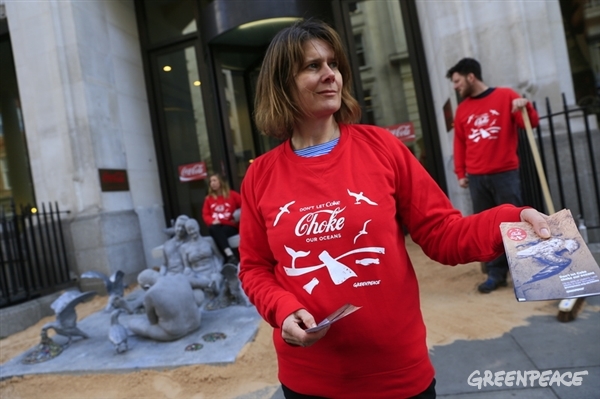
As the world’s largest soft drinks company, Coca-Cola has a special responsibility for the plastic that is wrecking our oceans. Here’s why we visited Coke HQ:
1. Coca-Cola has a huge plastic footprint (but it wants to keep it secret)
Coke produces over 100 billion throwaway plastic bottles every year, according to Greenpeace analysis – That’s a shocking 3,400 throwaway plastic bottles every second.
We’re having to rely on our own calculations from the limited information Coke makes available, because the company was the only one of the top 6 soft drinks brands that refused to own up to how much plastic it is selling every year.
But Coca Cola can’t hide the fact that billions of its plastic bottles are failing to be recovered every year and end up in the environment: on beaches, in landfill and in the oceans.
2. Throwaway culture
Single-use plastic bottles make up nearly 60% of all the drinks packaging Coke sells around the world. Given that Coke sells 1.9 billion drinks servings every single day – that’s a lot of plastic!
And these throwaway bottles are on the rise. Single-use plastic bottles make up 12% more of Coca-Cola’s packaging than they did a decade ago, while the proportion of refillable containers has dropped from just under a third to just a quarter. With our oceans choking on plastic pollution, Coke’s backtracking is unacceptable.
3. Recycling fail
Coca-Cola tells its customers that it’s their responsibility to recycle, but the soft drinks giant set it’s own 2015 target to get a mere 25% of plastic bottles from “recycled or renewable sources”. In fact, Coca-Cola currently uses a miserable 7% recycled content on average across its global plastic bottle sales.
After missing its 2015 target, Coke now has no further global targets to use more recycled content across its plastic bottles.
Coca Cola has not become any better at meeting the other environmental targets it has committed to. Coca-Cola is actually getting further away from its own 2020 goal to recover and recycle 75% of its drinks containers, with numbers of containers recovered and recycled dropping ever since the company set the goal in 2013.
4. Lobbying and greenwash
Coca-Cola claims to care about the environment, and spends huge sums sponsoring beach cleans and anti-litter campaigns. These schemes keep the focus firmly on Coke’s customers and distract from the company’s lacklustre efforts to reduce its own plastic footprint.
Behind these donations, the soft drinks giant has actually been lobbying hard against policy measures that can boost reuse and recycling. Coke has a history of opposing deposit return schemes across Australia, North America and Europe.
5. Coca-Cola can act to end ocean plastics
Coca-Cola knows it can’t ignore its plastic problem forever. Our action and new report makes that ever clearer.
With billion dollar profits and global reach, Coke has the means and the influence to make a big contribution to ending the flow of plastic into the ocean.
You can tell Coca-Cola to stop choking our oceans by emailing the European CEO, and call for Coke to embrace reusable packaging and ditch throwaway plastic once and for all. In the meantime, there’s no excuse for its packaging not to be made from 100% recycled content. Take action today – our oceans can’t stomach any more plastic.
Coca-Cola needs to stop choking our oceans. Read our report ‘The case against Coca-Cola’
